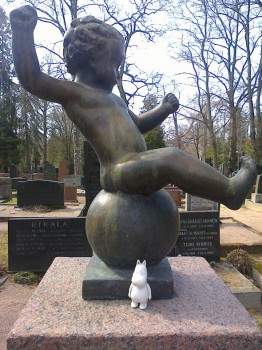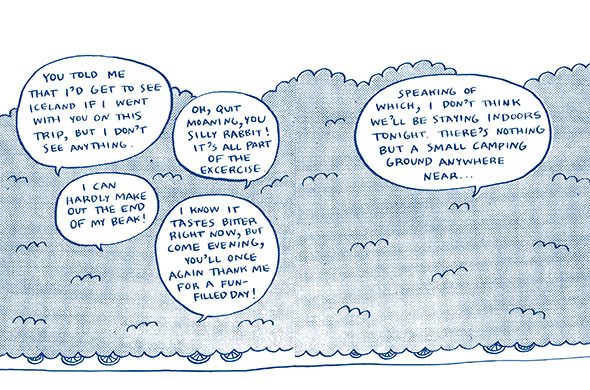Archive for 2014
Martin Panelius & Risto Santti & Jarkko S. Tuusvuori: Käsikirja [The hand book]
8 May 2014 | Mini reviews, Reviews
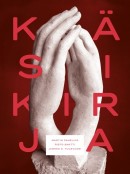 Käsikirja
Käsikirja
[Handbook]
Helsinki: Teos, 2013. 761 pp., ill .
ISBN 978-951-851-523-7
€37, hardback
Human development and human life are in many ways linked to the hand – and yet we seldom think about its significance. In their accessibly written and comprehensive Käsikirja, Emeritus Professors Martin Panelius and Risto Santti are joined by researcher Jarkko S. Tuusvuori in considering the body’s upper extremity from various points of view. The authors’ expertise in their own fields – neurology, anatomy and philosophy – set the book’s tone, but it goes far beyond these. The structure and functions of the hand are examined, as are its phylogeny, its neural networks, its aging process, its use in skills, and the injuries and illnesses that threaten it. The book deals with the hand’s connection with language and communication, its social significance, and the importance of human touch. There are a great many details, terms and names, but the artwork, the beautiful layout, the examples and the literary selections enliven the narrative. A multi-faceted achievement, Käsikirja is a refreshingly original work of non-fiction.
Translated by David McDuff
The nursemaid
Lapsenpiika (‘The nursemaid’), a short story, first published in the newspaper Keski-Suomi in December, 1887. Minna Canth and a new biography introduced by Mervi Kantokorpi
‘Emmi, hey, get up, don’t you hear the bell, the lady wants you! Emmi! Bless the girl, will nothing wake her? Emmi, Emmi!’
At last, Silja got her to show some signs of life. Emmi sat up, mumbled something, and rubbed her eyes. She still felt dreadfully sleepy.
‘What time is it?’
‘Getting on for five.’
Five? She had had three hours in bed. It had been half-past one before she finished the washing-up: there had been visitors that evening, as usual, and for two nights before that she had had to stay up because of the child; the lady had gone off to a wedding, and baby Lilli had refused to content herself with her sugar-dummy. Was it any wonder that Emmi wanted to sleep? More…
Rock or baroque?
30 April 2014 | Extracts, Non-fiction
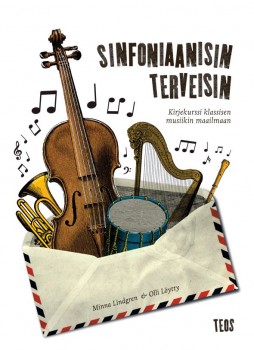 What if your old favourites lose their flavour? Could there be a way of broadening one’s views? Scholar Olli Löytty began thinking that there might be more to music than 1980s rock, so he turned to the music writer Minna Lindgren who was delighted by the chance of introducing him the enormous garden of classical music. In their correspondence they discussed – and argued about – the creativity of orchestra musicians, the significance of rhythm and whether the emotional approach to music might not be the only one. Their letters, from 2009 to 2013, an entertaining musical conversation, became a book. Extracts from Sinfoniaanisin terveisin. Kirjekurssi klassisen musiikin maailmaan (‘With symphonical greetings. A correspondence course in classical music’)
What if your old favourites lose their flavour? Could there be a way of broadening one’s views? Scholar Olli Löytty began thinking that there might be more to music than 1980s rock, so he turned to the music writer Minna Lindgren who was delighted by the chance of introducing him the enormous garden of classical music. In their correspondence they discussed – and argued about – the creativity of orchestra musicians, the significance of rhythm and whether the emotional approach to music might not be the only one. Their letters, from 2009 to 2013, an entertaining musical conversation, became a book. Extracts from Sinfoniaanisin terveisin. Kirjekurssi klassisen musiikin maailmaan (‘With symphonical greetings. A correspondence course in classical music’)
Olli, 19 March, 2009
Dear expert,
I never imagined that the day would come when I would say that rock had begun to sound rather boring. There are seldom, any more, the moments when some piece sweeps you away and makes you want to listen to more of the same. I derive my greatest enjoyment from the favourites of my youth, and that is, I think, rather alarming, as I consider people to be naturally curious beings whom new experiences, extending their range of experiences and sensations, brings nothing but good.
Singing along, with practised wistfulness, to Eppu Normaali’s ‘Murheellisten laulujen maa’ (‘The land of sad songs’) alone in the car doesn’t provide much in the way of inspiration. It really is time to find something new to listen to! My situation is already so desperate that I am prepared to seek musical stimulation from as distant a world as classical music. I know more about the African roots of rock than about the birth of western music, the music that is known as classical. But it looks and sounds like such an unapproachable culture that I badly need help on my voyage of exploration. Where should I start, when I don’t really know anything? More…
Juhani Suomi: Mannerheim – viimeinen kortti? Ylipäällikkö-presidentti [Finland plays its last card – Mannerheim, Commander-in-chief and President]
30 April 2014 | Mini reviews, Reviews
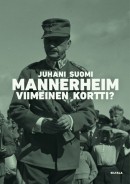 Mannerheim – viimeinen kortti? Ylipäällikkö-presidentti
Mannerheim – viimeinen kortti? Ylipäällikkö-presidentti
[Finland plays its last card – Mannerheim, Commander-in-chief and President]
Helsinki: Siltala, 2013. 836 pp., ill.
ISBN 978-952-234-172-3
€32, hardback
In his book Professor Juhani Suomi – well-known as the biographer of President Urho Kekkonen – focuses on the life and actions of Marshal Gustaf Mannerheim (1867–1951) during the final phase of the Continuation War between Finland and the Soviet Union beginning in1943 and, in particular, during his term as Finnish President from 1944 to 1946. Mannerheim was elected President by exceptional procedure, and his difficult task was to lead Finland from war to peace, which he succeeded in doing. Suomi seeks to reply specifically to the question of whether Mannerheim lived up to the myth that was created about him, and of whether he was Finland’s last chance as the guarantor of the country’s independence during those fateful years, as he is often presented. On the basis of a number of sources, the author draws a critical portrait of an aristocrat: this was a man who was cold and vain, who at every turn thought mainly of his own posthumous reputation and who as an elderly leader was slow and fickle in his decisions – though the reader will not necessarily agree with all of Suomi’s conclusions. Well-written, occasionally a bit too detailed, his book vividly describes a dramatic period in Finland’s recent history.
Translated by David McDuff
Petri Pietiläinen: Koirien maailmanhistoria [A world history of dogs]
24 April 2014 | Mini reviews, Reviews
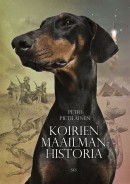 Koirien maailmanhistoria
Koirien maailmanhistoria
[A world history of dogs]
Helsinki: Finnish Literature Society, 2013. 344 pp .
ISBN 978-952-222-351-7
€34, hardback
By partly fictional means this book tells the compelling story of the dog, particularly from a cultural and historical perspective. Recent archaeological finds suggest that man has tamed dogs for more than 30,000 years. Descended from wolves, during the Stone Age they became common as domestic animals. In Finland, too, there have been finds that indicate that this was so. The dog was used for hunting and as a sentinel, and later in a variety of service tasks. From early on they were mythical creatures, worshipped in some cultures, in others shunned, and in some bred to be eaten. While in 17th-century Europe dogs were sentenced to death at trials, in Japan it was nobles who faced the death penalty for ill-treating their dogs. The book also presents the fascinating stories of dogs both famous and nameless, beginning with Alexander the Great’s dog Peritas. In the Western world the dog was not treated as a member of the family until the modern era, though in prehistoric burial sites there are indications of its having been a close companion of man. Pietiläinen links the story of the dog to more general history in an insightful way.
Translated by David McDuff
Online, offline?
17 April 2014 | Articles, Non-fiction

‘The bookworm’ (old-fashioned) by Carl Spitzweg, ca. 1850. Museum Georg Schäfer. Photo: Wikimedia
Ebooks are not books, says Teemu Manninen, and publishers who do not know what marketing them is about, may eventually find they are not publishers any more
At least once a year, there is an article in a major Finnish newspaper that asks: ‘So, what about the ebook?’ The answer is, as always: ‘Nothing much.’
It’s true. The revolution still hasn’t arrived, the future still isn’t here, the publishers still aren’t making money. In Finland, the ebook doesn’t seem to thrive. The sales have stagnated, and large bookstores like the Academic Bookstore are closing their ebook services due to a lack of customers.
Why is Finland such a backwater? Why don’t Finns buy ebooks?
The usual explanation is that Finland is a small country with a weird language, so the large ebook platforms like Amazon’s Kindle and Apple’s iBook store have not taken off here. Another patsy we can all easily blame is the government, which has placed a high 24% sales tax on the ebook. If that isn’t enough, we can always point a finger at the lack of devices and applications or whatever technical difficulty we can think of. More…
Antti Kujala: Neukkujen taskussa? Kekkonen, suomalaiset puolueet ja Neuvostoliitto 1956–71 [In the Soviets’ pocket? Kekkonen, the Finnish political parties and the Soviet Union 1956–71]
17 April 2014 | Mini reviews, Reviews
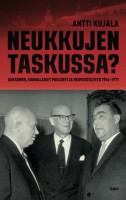 Neukkujen taskussa? Kekkonen, suomalaiset puolueet ja Neuvostoliitto 1956–71
Neukkujen taskussa? Kekkonen, suomalaiset puolueet ja Neuvostoliitto 1956–71
[In the Soviets’ pocket? Kekkonen, the Finnish political parties and the Soviet Union 1956–71]
Helsinki: Tammi, 2013. 392 pp., ill .
ISBN 978-951-31-7347-0
€39, hardback
In this book, which partly cites new sources in Russia, associate history professor Antti Kujala describes the nature of the policy pursued by President Urho Kekkonen during his term of office from 1956 to 19971 (he resigned in 1981). The parties were divided among themselves, and also to some extent internally. In political plotting secret support was sought after from both the Soviet Union and the West. Kekkonen was able to achieve a strong position, which he made use of. He sought to safeguard Finland’s interests with regard to the Soviet Union and created a good relationship with its leaders. At home, however, he used his position as a weapon against his opponents and tried to restrain criticism that could easily be interpreted as anti-Soviet. The Soviet Union viewed Finland as lying within its sphere of power and was able to influence many Finnish politicians and union leaders, as well as the composition of the government. The section of the book in question contains an account of the central phenomena of Finland’s political history: the influence of the Soviet Union, as manifested by the ‘night frosts’ and the so-called ‘Note Crisis’, and Finland’s reactions to the occupation of Czechoslovakia by Soviet troops in 1968.
Translated by David McDuff
Through thick and thin
10 April 2014 | Comics, Fiction
Kaisa Leka is a thirty-something graphic artist who is into yoga and cycling, among other things. With her husband Christoffer they have pedalled, as ‘cyclotourists’, around in Iceland, eastern Europe, from Porvoo to Nice.
Cycling without calf muscles is not plain sailing though – Kaisa lost her legs to (voluntary) amputation in 2002, as her feet were malformed from birth and walking was getting more and more painful. She feels completely at ease with her technologically advanced new legs.
In their graphic novel Cycling around Iceland (2012) Kaisa and Christoffer describe their adventure (1,385 km, in 18 days). Not plain sailing, either: the wind in Iceland goes against you more often than not. In these extracts Christoffer gives a talk about the journey and shows slides to a small mixed audience. In Kaisa’s comics she herself is a mouse and Christoffer a duck. In this good-natured, humorous story they always support each other, come rain or shine.
Timo Vihavainen: Ryssäviha. Venäjän-pelon historia [Ryssäviha. A history of Russophobia in Finland]
10 April 2014 | Mini reviews, Reviews
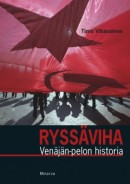 Ryssäviha. Venäjän-pelon historia
Ryssäviha. Venäjän-pelon historia
[Ryssäviha. A history of Russophobia in Finland]
Helsinki: Minerva Kustannus Oy, 2013. 322 pp.
ISBN 978-952-492-778-9
€31.90, hardback
In this well-written polemical study Professor Timo Vihavainen examines Russophobia mainly from a Finnish point of view, but also in a European context. He also writes about the reverse phenomenon, the emergence in Russia of xenophobia and accusations of ‘Russophobia’ among neighbouring countries. In 20th-century Europe it was more a question of opposition to the Soviet Union and its ideological system than of Russophobia as such. During the late 19th century Finland, which had been part of Russia from 1809 to 1917, saw the rise of so-called ryssäviha, ‘Russia-hate’, which began in the period of Russification and increased during the Civil War of 1917–1918. Between the World Wars it persisted especially in Akateeminen Karjala-Seura (‘The Academic Karelia Society’), a right-wing student organisation, and was fuelled by reports of political terror from across the eastern border, though even then a significant part of Finland’s working class saw the Soviet Union in a favourable light. During the Second World War ryssäviha came to a head in response to a conflict perceived as unjust, and to territorial concessions. In the 1960s, partly for political reasons, anti-Soviet sentiment became replaced by pro-Soviet attitude. Since the break-up of the Soviet Union in the 1990s relations with Russia have largely been free of problems.
Translated by David McDuff
Favour and fame: becoming a best-seller
10 April 2014 | In the news
 At the top of the list of best-selling books – compiled by the Finnish Booksellers’ Association – in March was the first novel by Tommi Kinnunen, a teacher of Finnish language and literature from Turku. In Neljäntienristeys (‘The crossing of four roads’, WSOY) the narrative spans a century beginning in the late 19th century and is set mainly in Northern Finland, focusing on the lives of four people related to each other. Undoubtedly well-written, it continues the popular tradition of realistic novels set in the 20th-century Finland.
At the top of the list of best-selling books – compiled by the Finnish Booksellers’ Association – in March was the first novel by Tommi Kinnunen, a teacher of Finnish language and literature from Turku. In Neljäntienristeys (‘The crossing of four roads’, WSOY) the narrative spans a century beginning in the late 19th century and is set mainly in Northern Finland, focusing on the lives of four people related to each other. Undoubtedly well-written, it continues the popular tradition of realistic novels set in the 20th-century Finland.
Finland is a small country with one exceptionally large newspaper, Helsingin Sanomat (read by more than 800,000 people daily). The annual literary prize that carries the paper’s name is awarded to a best first work, and candidates are assessed throughout the year.
In February the paper’s literary critic Antti Majander declared in his review of Kinnunen’s book: ’Such weighty and sure-footed prose debuts appear seldom. If I were to say a couple of times in a decade, I would probably be being over-enthusiastic. But let it be. Critics’ measuring sticks are destined for the bonfire.’ More…
The almost nearly perfect travel book
4 April 2014 | Articles, Non-fiction
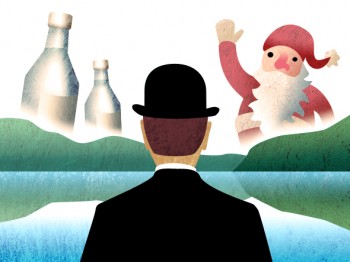
Illustration: Joonas Väänänen
The question of what foreign people think of us Finns, and Finland has always been a particularly burning one in these latitudes: a young nation, a small people. Can we be as good as bigger and wealthier nations? Tommi Uschanov reads a new book on the Nordic countries published in England, keeping a sharp eye on what is being said about…. Finland, naturally
When an article based on The Almost Nearly Perfect People: The Truth About the Nordic Miracle by Michael Booth was published last January in the London Guardian, there was a nationwide outcry in Finland. ‘Finland being bashed in the British media,’ one tabloid headlined grandiosely, while a sober financial paper spoke of ‘a broadside full of stinky stuff’. It takes a re-reading of the article after having read the book to understand why. To create an artificial atmosphere of controversy, the article is lop-sidedly critical of Finland in a way which the book goes out of its way to avoid.
The Almost Nearly Perfect People belongs in a by now time-honoured genre within English letters: the humorous encomium to a host culture by an expatriate – or immigrant, as we hosts impolitely insist on calling them. The only difference is that Michael Booth, a British food and travel writer, does not discuss only Denmark, where he has lived for a decade, but visits each of the other four Nordic countries in turn. More…
Rauhan ytimessä. Sadankomitea 50 vuotta [In the core of peace. Sadankomitea at 50]
3 April 2014 | Mini reviews, Reviews
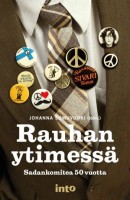 Rauhan ytimessä. Sadankomitea 50 vuotta
Rauhan ytimessä. Sadankomitea 50 vuotta
[In the core of peace. Sadankomitea at 50]
Toim. [Ed. by] Johanna Sumuvuori
Helsinki: Into, 2013. 170 pp., ill .
ISBN 978-952-264-264-6
€23, paperback
The nonpartisan Sadankomitea (‘Committee of 100’) peace organisation was founded in Finland in 1963 by the young radicals of their time. The movement was inspired by certain British non-governmental organisations. Its policies were established by research, discussion and writing rather than by direct action and marching. An important feature of the movement, especially during the Cold War, was its distinction from Rauhanpuolustajat (The Finnish Peace Committee), which was considered to be a mouthpiece of the Soviet Union. The movement’s discussion forum was the journal Ydin (‘The core’), founded in 1967, whose articles had more weight than its circulation might have suggested, a fact that also indicates Sadankomitea’s influence. This commemorative book contains a dozen or so articles in which peace movement veterans – including Finland’s foreign minister Erkki Tuomioja, who is a founding member – and younger activists discuss the movement’s work for peace. The fascinating articles range from personal recollections to analytical overviews.
Translated by David McDuff
Homeward bound!
29 March 2014 | This 'n' that
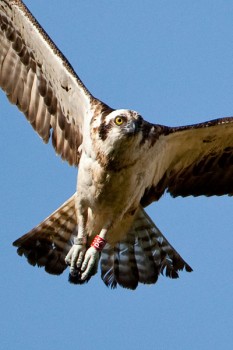
Jukka the osprey: sadly, his fate remains unknown. Photo: Hannu Vainiopekka
Snow is now, unusually for so early in the year, long gone from more than half of Finland. Bears are waking up and emerging from their winter lairs: spring is definitely in the air!
So are birds: the latest news from Cameroon is that on 26 March Ilmari caught his last African fishes and started winging his way to southern Finland.
Ilmari is an osprey: you may remember him – we reported his endeavour to cross continents on his way to Africa in 2012, asking you to watch this space. Well, the raptor is still doing fine, and his journey can be followed on the Finnish Museum of Natural History’s Luomus website. More than six thousand kilometres and a month later he will hopefully be spotted fishing on his home lakes in Hattula.
Let’s keep our fingers crossed for Ilmari. The fates of his compadres Pete, Eikka and Jukka are unfortunate: these great travellers perished on their particularly long and dangerous migration routes. Their stories are reported here.
Fan-male?
29 March 2014 | This 'n' that
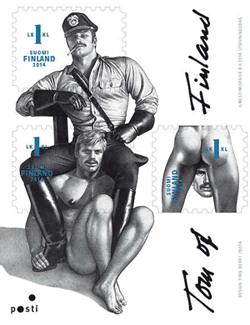 It is one of the enduring peculiarities of Finnish culture, along with the national enthusiasms for heavy metal music and the tango, that Tom of Finland, an erotic artist who specialised in stylised pencil images of muscular and well-endowed men wearing tight or little clothing, should be regarded as a national treasure.
It is one of the enduring peculiarities of Finnish culture, along with the national enthusiasms for heavy metal music and the tango, that Tom of Finland, an erotic artist who specialised in stylised pencil images of muscular and well-endowed men wearing tight or little clothing, should be regarded as a national treasure.
Even more startling, according to our friends abroad, is the news that a collection of Tom’s images is to be issued as postage stamps in September this year, when an exhibition opens in the Postal Museum in Tampere. ‘Sealed with a Secret – Correspondence of Tom of Finland’ displays Laaksonen’s correspondence from the early 1940s to 1991.
As the Finnish post office, Itella Posti, remarks in its press release, Tom of Finland, or Touko Laaksonen (1920–1991), is one of the most well-known Finnish artists around the world. The images selected – which include a pair of buttocks with a moustached face peeking out from between the legs and a man in military uniform entwined with a naked one – stick to the tamer side of Tom’s work, but their stereotypical homoeroticism will nevertheless be, let’s say, striking additions to the envelopes on which they appear.
According to Timo Berry, the graphic artist who made the selection, the stamps portray ‘a sensual life force and being proud of oneself. There is never too much of that in this northern country.’
Opinions will differ as to the artistic merits of Tom of Finland’s work, but one thing is certain: it’s decidedly top-shelf material. The Finnish post office website features a discussion of whom one would send which stamps to: you wouldn’t, obviously, send Tom to your maiden aunt in the countryside, but the conversation doesn’t examine the fact that the images will not only be viewed by the addressee. How would you explain the pictures to your small children, for example?
Postage stamps are, traditionally, regarded as an expression of national identity – in that case it’s debatable what these are expressing, as Finland is not conspicuously friendly to the gay community. There is no gay marriage, and you can only legally change your gender after surgical sterilisation.
So why issue Tom of Finland as public art? We’re stumped. (On the other hand, we’re not convinced you need to regard stamps as an expression of national identity at all…)
Answers on a postcard, please. You choose the stamps. (Tom’s stamps are self-adhesive, by the way. You don’t have to, ahem, lick their backsides.)
Remembrance
29 March 2014 | This 'n' that
 This year is the centenary of Tove Jansson (1914–2001), the painter, caricaturist, comic strip artist, illustrator and author of books for both children and adults, and, what made her name internationally, the creator of the Moomins. Today, her Moomin books are available in 40 languages.
This year is the centenary of Tove Jansson (1914–2001), the painter, caricaturist, comic strip artist, illustrator and author of books for both children and adults, and, what made her name internationally, the creator of the Moomins. Today, her Moomin books are available in 40 languages.
One sunny April day, walking through the atmospheric old Hietaniemi cemetery by the sea in Helsinki, a charming little bronze statue on top of a narrow granite column caught my eye.
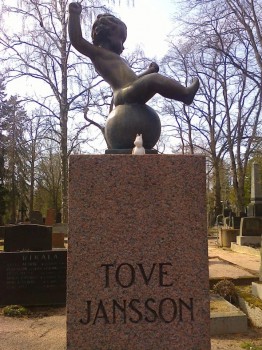
Family grave: sculpture by Victor Jansson
It was a small child balancing on a ball, waving its arms and legs joyously in the air. On a closer look, there was something white attached to the statue: it was a tiny white plastic Moomin.
On the Janssons’ family grave the first little blue flowers had just risen to the surface to bask in the early spring sun. Tove’s father was the sculptor Victor Jansson, her mother was the cartoonist and artist Signe Hammarsten Jansson.
Perhaps one of Tove’s fans had chosen this way of paying homage to the creator of the unique Moomin universe.
